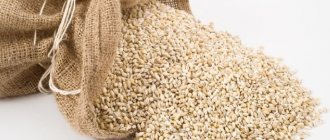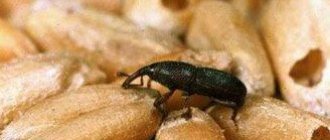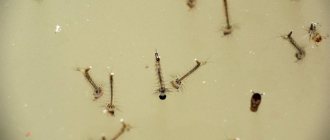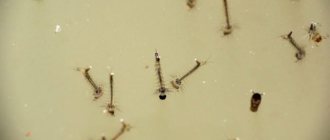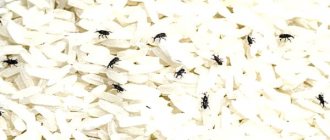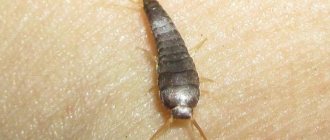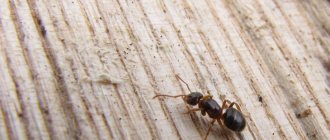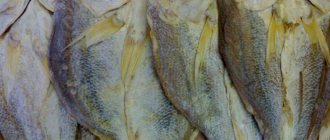Why do bugs appear in cereals, how to get rid of pests and which cereals are most susceptible to their influence? First of all, you need to understand that bugs only appear where there is constant access to food. Insects are attracted to loose materials not only in open containers and bags, but also when scattered on shelves and in cabinets.
Cereals and pasta are a favorite treat not only for bugs, but also for food moths. Insects also actively eat cereals, crackers, dried fruits, bread; they can be found in spices and food concentrates.
What bugs are found in the kitchen and how do they get there?
It’s not enough to discover that there are bugs in flour and cereals, damaging products with lightning speed. To choose effective pest control products, you need to clearly know what type they belong to. There are several main types of bugs that damage bulk products:
- bread grinder;
- flour bug;
- red mucous eater;
- food moth.
Bread grinders are miniature light brown bugs that can fly; they most often settle in cereals; they enjoy baked goods, old medicinal herbs, as well as tea and coffee with great pleasure. They enter the apartment with contaminated store products, as well as animal feed.
Flour bugs settle in flour more often than in any other product; they can often be found in bags of starch. Insects simply penetrate boxes in the kitchen with bulk products, including packages of rye, rice flour, rolled oats and semolina. Infrequently, you can see pests in dried fruits, rice or buckwheat.
The peculiarity of insects is the ability to reproduce quickly. Female beetles camouflage their oviposition in crevices of furniture in the kitchen, in cereals, flour, and on cabinet shelves. A new generation of pests quickly spreads throughout the home in search of food sources.
The red common mucoed is no more than 2.5 mm long. It most often enters the premises together with low-quality animal feed. The pest’s favorite food is cereals, grains, flour with an expired shelf life and a moisture content of no more than 15%. In order for the red flour beetle to stop spoiling food and breeding in the kitchen, it is enough to block access to food sources.
The food moth infests in buckwheat, rolled oats, semolina, rice, flour. A mature individual visually resembles a silver butterfly and reaches a length of 10 cm. Its appearance in the kitchen is associated with violation of food storage rules; in addition, the insect enters the house through ventilation holes and open windows.
In addition to the fact that insects are found in semolina, millet and other cereals, in some cases tea and cocoa, dried fruits, and pasta are also infected.
It is not difficult to identify pests in products - they leave behind a thin web woven from small yellow worms.
Preventive measures: how to prevent infection?
To prevent insects in cereals from complicating your life by requiring a number of operations to destroy them, you can follow simple recommendations regarding the prevention of their appearance. These include:
- Warm up the purchased cereals in the oven at low temperature for half an hour.
- Freezing bulk products in the freezer for 24 hours (use dry, ventilated packaging).
- Dried fruits are treated with boiling water, followed by washing and storing exclusively in the refrigerator.
- Thorough inspection of purchased products (including vacuum packaging) with disposal of cereals and flour with signs of contamination.
Bulk materials should be stored in perforated polyethylene or closed glass containers. As an alternative, metal boxes and ecological bags made of natural linen are suitable.
One of the reasons why bugs appear in flour and cereals is failure to comply with the shelf life of products. To avoid creating conditions favorable for pests, it is worth buying cereals and other bulk products, as well as dried fruits, coffee and tea with a minimum supply.
It is believed that rice, semolina, flour and buckwheat can be stored for no more than six months; oatmeal and millet can be stored for no more than 4 months due to their high fat content.
The record holder for shelf life is polished rice. Many varieties become even better after several years of storage, acquiring additional taste.
If you still cannot avoid contamination of food in the kitchen, you can get rid of bugs in cereals, flour and spices in several ways.
How to get rid of insects in cereals and flour
Having dealt with the products, they proceed to the next stage - the destruction of traces of insect activity. If this is not done, then the question of how to get rid of brown bugs in the kitchen will arise before you with unenviable regularity. Parasites lay their eggs in a variety of places, so their larvae can appear anywhere in the food cabinet.
To ensure that little brown bugs in the kitchen don’t have a chance, you need to thoroughly disinfect all shelves and containers located on them. The cabinet is completely emptied of bags and containers, after which all food debris (spilled flour, cereal, etc.) is carefully swept out. The latter need to be flushed down the toilet. Never be frugal. Even if there are no beetles in the flour, traces of their presence may remain.
The shelves are wiped with a vinegar solution. One tablespoon of vinegar for a liter of water is enough. When there are bugs in your kitchen cabinet, getting rid of them is not so easy. They leave eggs in almost imperceptible crevices, so heat treatment will also be required. All places where there is even the slightest suspicion of holes should be poured with boiling water.
During the procedure called “fighting beetles in cereals”, it is necessary to pay sufficient attention to the containers used to store products. The jars are thoroughly washed with laundry soap and then doused with boiling water. Bags and bags made of fabric are treated with saline solution. Once they dry out, the beetles in the rice will definitely not be able to lay eggs. There is no need to rinse the material.
If you are not sure that you have managed to finally get rid of black bugs in the kitchen, you can use folk remedies. The first method is to use homemade bait. Mix fine grains with powdered sugar and brown sugar in equal proportions. The resulting composition is laid out on paper sheets and placed on shelves. This mixture is completely safe for us, but it really helps to get rid of bugs in the kitchen in cereals and flour.
The second option is to purchase pyrethrum at the pharmacy, made from chamomile (Persian, Caucasian). You can simply sprinkle the powder on the shelves or pour it into linen bags. This very effective remedy for bugs in cereals also does not pose any threat to human health.
It is quite natural that when thinking about how to get rid of insects in cereals, the possibility of using chemicals is considered last. Moreover, as a rule, it is possible to cope with the problem with “clean” means. But if the measures described above do not bring results, the following drugs can help get rid of midges in cereals:
- "Anti-bug";
- chalk “Mashenka”;
- "Karbofos".
What to do if there are bugs in the kitchen and your financial options are limited? Chalk "Mashenka" costs 5-6 times cheaper than the next most affordable "Karbofos". To repel insects, you only need to coat the inside corners of the cabinets. Antizhuk is the most expensive, but it has the highest efficiency on this list.
The advantage of Karbofos is the variety of forms: tablets, aerosol, powder, liquid. If you decide to get rid of bugs in cereals and flour in the kitchen using chemicals, carefully follow the instructions. It is important that the treated areas are inaccessible to animals. The poison, designed for small parasites, is poison for both dogs and cats.
Defeating this little pest of mucous is not as easy as it seems at first glance. The fact is that they lay their eggs in any place and are completely unnoticeable.
You may not even see them on a bag of spoiled cereal, where, after you shake it out, they continue to multiply. There is no effective way to get rid of brown bugs in the kitchen, but we will try to give you some tips.
You'll need
- Disinfectant;
- Glass jars with lids;
- Bay leaf;
- Muscat;
- Garlic.
Stages
- All infected packages should be scanned. Even if there are not many bugs, you will have to throw away the cereal, since the eggs will still remain. Look at flour, unopened bags, crackers, and indeed all bread and cereal products. The favorite delicacy of these bugs is flour, so it is better to throw it away immediately.
- Thoroughly rinse the cabinets with hot water and vinegar or Domestos or any other disinfectant. For complete destruction, it is better to do this procedure several times. Cereals that have not been contaminated should be placed in plastic bags and put on the balcony or in the refrigerator for a couple of weeks. After this time, making sure that no bugs have appeared, pour the cereal into a glass container with lids. How to get rid of kitchen bugs? We've almost got it done.
- Place bay leaves in the cabinets, peel the garlic and place in the corners. Sprinkle nutmeg onto the adhesive plaster and also place it in the corners of the cabinet.
Prevention measures
Let's assume that you have destroyed the bugs and your cereals have been left in the cold for the allotted time.
How can we avoid such surprises in the future?
- Make bags from canvas material. Boil them in a strong salt solution for 30 minutes. Let it also cool in the solution and only then squeeze out the bags. Then you should dry them at room temperature and iron them with a hot iron. Bugs will no longer appear in bags treated with salt in this way.
- You can also bring bugs from the store, so after you have bought the cereals, it is best to place them in the freezer for several days. It is better to store nuts and raisins in the refrigerator, and cereals in bags or glass jars. How to get rid of bugs in the kitchen is not as difficult a problem as it seems.
Recycling is a simple and reliable method
When there is neither the desire nor the ability to fight the increasing population of harmful insects in bulk products in the kitchen, it is worth moving on to a radical method - recycling damaged cereals.
Packages, sacks, containers with bugs are carefully packed in sealed cellophane and taken out of the house.
Places where contaminated products were stored (shelves, cabinets, mezzanines) are thoroughly treated with soda, vinegar or chlorine solution, followed by rinsing with clean water.
Thermal fighting - what effect does it give?
If there are bugs in the cereal, you can try to remove them by raising the temperature to +50 degrees Celsius. We are talking about treating containers with pests with boiling water or steam. The method is especially effective for removing pests in hard-to-reach places.
To free cereals and other bulk products from insects, you can dry them in the oven at temperatures up to 70 degrees for half an hour, or achieve the result by placing contaminated products in the freezer. Most bugs die at a temperature of -15 degrees Celsius.
After destroying the larvae and bugs from the kitchen cabinets and shelves, it is important not to forget to treat the surfaces, as well as all existing cereals, nuts, and beans. As a result of this treatment, it will be possible to get rid of the remaining insects that will simply float to the surface. However, given that products contaminated with insects are unfit for consumption, it is easier to get rid of them by replenishing supplies with fresh cereals and flour.
If there are bugs in the flour, can it be used?
If you are thinking about how to get rid of bugs in the kitchen and at the same time do not want to throw away spoiled food entirely, the processing should be as thorough as possible. In the case of flour, you will need a sieve with the smallest mesh possible. Not only adults should remain on the grill, but also the larvae and debris they produce.
However, it is not enough to simply remove insects in flour in the kitchen. To gain complete confidence in the safety of purified food, it must be subjected to thorough heat treatment. There are two ways to influence insects with temperature. You can finally get rid of the flour bug by placing the sifted mixture in the oven.
What to do if insects are found in cereals? How to get rid of them without throwing away the entire product. In such situations, the cleaning process is even easier. Simply pour salt water over the rice, beans or beans and leave for a few minutes. After some time, all the bugs in the cereal will separate from the main mass and float up, as well as their derivatives.
We invite you to familiarize yourself with Expired coffee capsules. Is it possible to drink expired coffee? Let's discuss
Restorative actions make sense only when only a small part of the main mass is affected. If insects in cereals or flour have left behind an impressive “web” of yellow worms, you should come to terms with the loss and do everything to ensure that a similar situation does not happen again. Spoiled food should be thrown away along with its container. The bag or sack is carefully packed in sealed cellophane and only then taken out of the house.
Before you completely remove the bugs that have infested in cereals and cupboards, you need to throw away all the cereals in which they were found. Some people cook this cereal and feed it to backyard birds, which are not afraid of bugs; this is their daily food.
You cannot limit yourself to simply getting rid of contaminated products. After all, larvae can be on packages with other products that were lying nearby, on doors, and in the corners of cabinets.
The next thing you should definitely do when fighting bugs is to wash the cabinet with detergent and then treat it with vinegar. Banks in which spoiled cereals were stored must also be processed.
In order not to think about how to remove bugs from cereals or flour, you can take some measures that will prevent them from appearing and multiplying.
Pests cannot tolerate strong odors. Therefore, garlic, bay leaves, and cloves placed in cabinets will help prevent the appearance of bugs.
If you buy cereal or flour in a store, you can also bring insects home. To prevent this, you can put the bags in the freezer for a while or store them permanently in the refrigerator.
Many thrifty owners are interested in what to do if there are bugs in the rice. Is it possible to eat it or is it better to immediately throw it away out of harm’s way? Ideally, spoiled products should be disposed of. Elementary disgust has not yet been abolished, in addition, even a mass thoroughly cleaned of adult individuals may contain the remnants of their vital activity.
What to do if insects are found in cereals? How to get rid of them without throwing away the entire product. In such situations, the cleaning process is even easier. Simply pour salt water over the rice, beans or beans and leave for a few minutes. After some time, all the bugs in the cereal will separate from the main mass and float up, as well as their derivatives.
Chemicals in pest control
If there are bugs in the cereal, what should you do when the previous methods above do not give the desired effect? In such cases, it makes sense to use chemicals. The active drugs are Karbafos and Antizhuk. The second has a universal effect, helping to cope not only with kitchen bugs, but also with wood bugs that damage furniture, windows, laminate and parquet. The drug must be used with extreme caution, following the instructions.
Another remedy against pests, Rogneda, is a powerful antiseptic that allows you to dispose of a number of domestic insects, including mucous beetles, weevils, cockroaches and ants.
You can also remove bugs from the kitchen using the drug “Lovin Fire Protection”, which allows you to achieve a quick effect. The product has a high level of toxicity and is used when there are no animals or children at home.
Video
Simple and affordable methods will help you cope with pests in the kitchen. To understand the intricacies of their use, watch the presented videos:
About the author:
Found a mistake? Select the text with the mouse and click:
Do you know that:
The easiest way to remove scale and carbon deposits from the soleplate of the iron is with table salt. Pour a thick layer of salt onto the paper, heat the iron to maximum and run the iron over the salt bed several times, applying light pressure.
Working folk methods: which ones to choose?
Those who consider chemicals too dangerous and the disposal and destruction of insects by lowering or raising temperatures are not so effective should try to solve the problem with the help of folk remedies. Recipes for some of them are below:
- Table vinegar. All surfaces infected with the bug are treated with a vinegar-based water solution, along with the simultaneous disposal of cereals and flour damaged by pests.
- Bay leaf, pepper, garlic, sulfur. All of these are products whose smell is feared not only by flour bugs (the photo below will prevent you from making mistakes in identifying pests), but by other types of insects.
- Antiseptics of natural origin - chamomile or calendula can also repel pests.
An interesting option that allows you to forget, if not forever, then for a long time, what bugs in cereals are (a photo will help you correctly identify the type of each) is a trap based on boric acid.
Bait works on a simple principle: insects are attracted to the bait. Hungry bugs try a poisoned treat, become infected with toxins and poison the rest of the colony.
To prepare the bait, boric acid is mixed in a container with powdered sugar, semolina, honey, and syrup. Treats will only attract pests if they are fresh. It is recommended to use traps when children and pets are not at home, placing them in insect habitats.
Chemicals
If the beetle has infected all the products, then it is much more advisable to treat the infected room with insecticides. Below are the drugs that are used to combat small and large flour beetles.
Phosphine
A gas produced by mixing phosphorus with hot alkali. In agricultural stores it is sold in the form of blocks for fumigation, containing substances that synthesize this chemical element when heated.
Phosphine affects the nervous system and disrupts the metabolism of insects, including the flour beetle. It is also effective against other pests.
Expert opinion
Mityuk Stefania Bogdanovna
The connection is also dangerous for humans. During the fumigation of the room, you must leave it and return only after 10 - 12 hours. The treatment area must be well ventilated.
Borax
Relatively safe product. Effective against adults, but not against larvae. Borax is mixed with flour and sugar and placed in areas where the parasite is expected to live. When ingested by a beetle, the substance causes severe dehydration, resulting in death.
Ozone
Flour beetles do not tolerate air saturated with ozone. Therefore, ionizers are used to combat them. They are left on for several hours in the room being treated.
Ozone is also toxic to humans. Therefore, the room must be well ventilated before using it.
Insecticide solutions are also used against the beetle. However, it is strictly forbidden to use them for food processing - you can get poisoned. Using solutions, the pest is removed from the seed.
